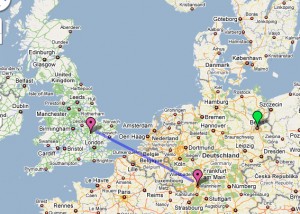16 Mar Mission 6 – January 7, 1944
The assigned target was I G Farben Industrie plant at Ludwigshafen deep into Germany. This was an important chemical factory, critical to supplying Germany’s war effort. An interesting aside is the fact that IG Farben also had a plant near Auschwitz which used slave laborers as workers. They manufactured the poison that was used in the gas chambers. After the war, several directors of the company were sentenced to prison by the U. S. for war crimes.

Thurleigh to Ludwigshafen. This mission was deep into Germany but I also marked Berlin in green to show how much farther that would be …
Donald L. Miller in his book “Masters of the Air” reported that aerotitis media accounted for two-thirds of the cases of temporary removal from flying duty. Herman’s diary for January 7th simply said: “This is going to be brief and to the point, for as result of this mission have cracked an ear drum and have to report to the hospital for a sojourn there – nothing serious.”
It was common for the B-17 crew members to suffer from aerotitis media, inflammation of the middle ear. The cabins were not pressurized and if the airman’s Eustachian tube was blocked due to a respiratory infection, the eardrum would often rupture. Donald L. Miller in his book “Masters of the Air” reports that this accounted for 2/3 of the cases of temporary removal from flying duty. The cabins were also not heated so at high altitudes, the temperature would be 40 degrees below zero or colder.
While we’re on the subject of ears, the intense noise in the B-17 bombers has caused many veterans to experience hearing loss later in life, and Herman is no exception. Even though the crew wore ear protection, it was not always effective. He has almost no hearing in one ear, and very little in the other. He spends half his waking hours adjusting his hearing aids. With his hearing aids in he can converse one on one fairly effectively. In a group it’s impossible. He’s lost.
As a result of Herman’s ruptured ear drum, the flight surgeon grounded him for a month. Four days later, his good friend Navigator Charles L. “Steve” Stephenson was “hit by a 30-30 caliber somewheres over Germany and is now buried at Cambridge.”
It was not a good time. Herman was out of commission from January 7th until February 11th. One would think that this could have been a very good thing (He was safe, right?) but the bomber boys were primarily concerned with reaching their goal of 25 missions.
6 down, 19 to go …


Tom Sanor
Posted at 14:34h, 18 MarchIn this chapter you quote a man as saying, “…hit by a 30-30 caliber somewheres over Germany…” A 30-30 is actually the name of a bullet used in a hunting rifle. The correct description (speaking of German aircraft guns) would be 30mm, without the word caliber. On the other hand since this is a quote you might wish to leave it as-stated, even though it is inaccurate.
Pat
Posted at 14:58h, 18 MarchTom, thank you so much for catching this. Out of curiosity, I went back to an early copy of my Dad’s diary (he retyped it a couple times through the years) and he did write 30-30. I am very grateful for any and all edits, suggestions, or additions!